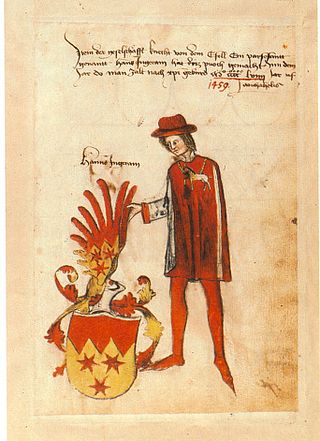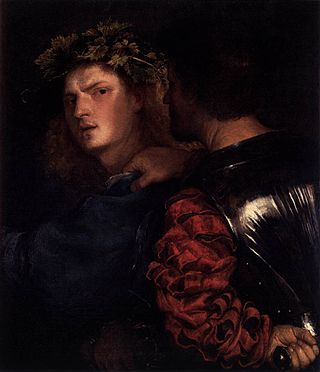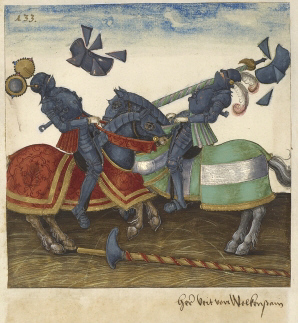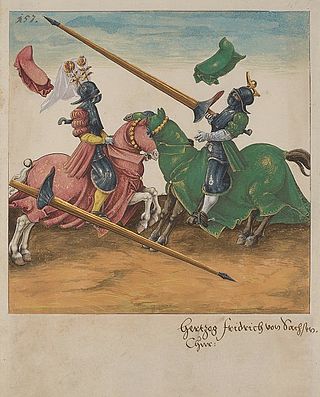
The Kunsthistorisches Museum is an art museum in Vienna, Austria. Housed in its festive palatial building on the Vienna Ring Road, it is crowned with an octagonal dome. The term Kunsthistorisches Museum applies to both the institution and the main building. It is the largest art museum in the country and one of the most important museums worldwide.

The Imperial Crown of Austria is a crown formerly in use by the monarchs of the Habsburg monarchy. The crown was originally made in 1602 in Prague by Jan Vermeyen as the personal crown of Holy Roman Emperor Rudolf II, and therefore is also known as the Crown of Emperor Rudolf II. The crown was used as a private crown of the Holy Roman Emperors and Kings of Hungary and Bohemia from the House of Habsburg. In 1804 it became the official crown of the newly constituted Austrian Empire. After 1867 it remained the imperial crown of the Cisleithanian part of the Austro-Hungarian Empire until 1918.

Archduke Leopold Wilhelm of Austria, younger brother of Emperor Ferdinand III, was an Austrian soldier, administrator and patron of the arts.

The Museum of Military History – Military History Institute in Vienna is the leading museum of the Austrian Armed Forces. It documents the history of Austrian military affairs through a wide range of exhibits comprising, above all, weapons, armours, tanks, aeroplanes, uniforms, flags, paintings, medals and badges of honour, photographs, battleship models, and documents. Although the museum is owned by the Federal Government, it is not affiliated with the Federal museums but is organised as a subordinate agency reporting directly to the Ministry of Defence and Sports.

Palais Rothschild refers to a number of palaces in Vienna, Austria, which were owned by members of the Austrian branch of the Rothschild banking family. Apart from their sheer size and elegance, they were famous for the huge collections of valuable paintings, statues, furniture, books and armour that they housed, another reflection of the family's vast wealth and prominent position.
Otto Benesch was an Austrian art historian. He was taught by Max Dvořák and is considered a member of the Vienna School of Art History. He is well known for his catalogue of Rembrandt's drawings. In 1942 he was awarded the Guggenheim Fellowship.

Maximilian armour is a modern term applied to the style of early 16th-century German plate armour associated with, and possibly first made for the Emperor Maximilian I. The armour is still white armour, made in plain steel, but it is decorated with many flutings that may also have played a role in deflecting the points and blades of assailants and increasing the structural strength of the plates. It is a transitional stage in the decoration of armour, after the plain steel surfaces of 15th-century armour and before the elaborate decoration and colouring with etching and other techniques of Renaissance armour. The armour is characterized by armets and close helmets with bellows visors; small fan-shaped narrow and parallel fluting—often covering most of the harness ; etching; work taken from woodcuts; sharply waisted cuirasses, and squared sabatons.

Ambras Castle is a Renaissance castle and palace located in the hills above Innsbruck, Austria. Ambras Castle is 632 metres (2,073 ft) above sea level. Considered one of the most popular tourist attractions of the Tyrol, Ambras Castle was built in the 16th century on the spot of an earlier 10th-century castle, which became the seat of power for the Counts of Andechs. The cultural and historical importance of the castle is closely connected with Archduke Ferdinand II (1529–1595) and served as his family's residence from 1567 to 1595. Ferdinand was one of history's most prominent collectors of art. The princely sovereign of Tyrol, son of Emperor Ferdinand I, ordered that the medieval fortress at Ambras be turned into a Renaissance castle as a gift for his wife Philippine Welser. The cultured humanist from the House of Habsburg accommodated his world-famous collections in a museum: the collections, still in the Lower Castle built specifically for that museum's purpose, make Ambras Castle one of the oldest museums in the world.
Gothic plate armour was the type of steel plate armour made in the Holy Roman Empire during the 15th century.

Lorenz Helmschmied or "Helmschmid" was a German armourer and a member of the Helmschmied family of armourers from Augsburg. He was one of the primary armourers to the Habsburg court of the Holy Roman Emperors Frederick III and Maximilian I, and created some of the most technically innovative and artistically complex armours of the late-fifteenth and early-sixteenth centuries.

Anton Peffenhauser (1525–1603) was the foremost armourer in Augsburg during the late 16th century. He was trained by members of the Helmschmied family. He frequently collaborated with the armor etcher, Jörg Sorg the Younger (1525–1603), his exact contemporary, and their works are documented in a manuscript known as the Stuttgarter Harnischmüsterbuch. Peffenhauser worked for numerous princes in the Holy Roman Empire and beyond, and his workshop was especially favored by the Prince-Electors of Saxony, the Dukes of Bavaria, and members of the Spanish court.

The Ingeram Codex is an armorial of the Holy Roman Empire made by Hans Ingeram for Albert VI, Archduke of Austria in 1459. It is largely concerned with the coats of arms of the Adelsgesellschaften fashionable at the time, a type of society or order formed by members of the lower nobility with the purpose of holding tournaments.

Wendelin Boeheim was an Austrian army officer and weapons historian.

The Bravo is an oil painting usually attributed to Titian, dated to around 1516-17 and now in the Kunsthistorisches Museum in Vienna. The painting can be seen as one of a number of Venetian paintings of the 1510s showing two or three half-length figures with heads close together, often with their expressions and interactions enigmatic. Most of these are "Giorgionesque" genre or tronie subjects where the subjects are anonymous, though the group includes Titian's The Tribute Money, with Christ as the main figure, which in terms of style is similar to this painting, and his Lucretia and her Husband, also in Vienna, where at least the woman's identity is clear, if not that of the man.

The Armor of Emperor Ferdinand I is a suit of plate armor created by the Nuremberg armorer Kunz Lochner in 1549 for the future Ferdinand I, Holy Roman Emperor. One of several suits of armor made for the Emperor Ferdinand during the wars of Reformation and conflict with the Ottomans, the etched but functional armor is thought by scholars to symbolize and document the role of the Habsburg Catholic monarchs as warriors on Europe's literal and ideological battlefields.
Ian Donald Dietrich Eaves,, is a British researcher and consultant on arms and armour. He served as the Keeper of Armour at the Royal Armouries for eighteen years, from 1978 to 1996. Also starting in 1978, and continuing until 1983, he served as the editor of the Journal of the Arms & Armour Society; he was appointed the society's president in 1995, and currently serves as a vice-president emeritus. He has written and translated several articles for journals, including the society's.
Heinz Magenheimer is an Austrian military historian known for advancing the now discredited theory of a preemptive strike by the Wehrmacht against the Soviet Union.

Freydal is an uncompleted illustrated prose narrative commissioned by the Holy Roman Emperor Maximilian I in the early 16th century. It was intended to be a romantic allegorical account of Maximilian's own participation in a series of jousting tournaments in the guise of the tale's eponymous hero, Freydal. In the story, Freydal takes part in the tournaments to prove that he is worthy to marry a princess, who is a fictionalised representation of Maximilian's late wife, Mary of Burgundy.
Hans Julius Leonhard Wilhelm August Tintelnot was a German art historian and painter. He was particularly concerned with the Baroque era.

The Freydal tournament book is an early 16th century illuminated manuscript held by the Kunsthistorisches Museum in Vienna containing 255 miniature paintings depicting scenes from a series of imaginary late medieval jousting tournaments. It was created by the court painters of the Holy Roman Emperor, Maximilian I with the intention that the miniatures would be used to illustrate one of the Emperor's "memorial" projects, a prose narrative to be called Freydal. The latter work was never completed in the form Maximilian intended, but the tournament book is one of three surviving elements of the project. The other two are a draft text of the narrative and over 200 drawings created as planning sketches for the miniatures in the tournament book.















